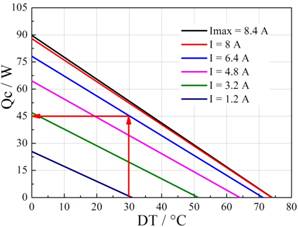Technical Support
Home > Technical Support
3. How do you select the right module to meet the requirement? |
||||||||||||||||||||||||
|
In most of applications, Peltier coolers are used to cool the object to the required temperature and maintain this temperature at the desired level. In other words, thermoelectric modules are supposed to ensure the certain difference between the ambient temperature and the cooled object temperature through heat removal from the object to the heat sink. Temperature difference ΔT is defined as a difference between the temperature of thermoelectric module hot side, used for heat removal from the module, and that of the module cold surface which ensures cooling the object down to the preset temperature. When choosing a module, it should be remembered that full thermal load Qc comprises the capacity needed to cool the object and other types of additional heat inflows from the environment owing to convection, heat emission and heat conductivity of the elements installed in the device. Thermoelectric modules are able to operate in two limit modes: Qcmax maximum cooling capacity mode (heat pump) at ΔT = 0 ∆Tmax maximum object cooling mode, at Qc = 0 In practice, however, only the combined operation mode is applied. ΔTmах and Qcmax are the basic thermal characteristics of the module. Analysis of a module's load curve may help to select a suitable Peltier module and optimize its operation mode. Baseline data for thermoelectric cooler selection: cooling capacity to be ensured by the module, Qс, W temperature difference between the module hot and cold sides Тh - Тc = ΔT (°C) The module's maximum cooling capacity required to ensure the preset temperature difference is defined with the following temperature: Qcmax = Qс × ΔTmax / (ΔTmax - ΔT), where: Qmax is module's maximum cooling capacity; Tmax is module's maximum temperature difference (74 °С for TEHC Series thermoelectric modules). Using the tables of thermoelectric module performance data, choose a Peltier module with the maximum cooling capacity equal or superior to the calculated maximum cooling capacity, considering the desired dimensions, supply voltage and current. Using the Qс vs temperature difference (Тh-Тc) curves, determine the module's operating current. Determine the chosen module's supply voltage by the value of operating current I and required temperature difference ΔT. Example: It is necessary to ensure temperature difference ΔT = 30 °C at module cooling capacity Qc = 45 W and module hot side temperature Тh = 27 °C. Determine the maximum cooling capacity of the suitable module: Qcmax = 45 × 74 / (74-30) = 75.7 W From Thermonamic`s Products list (http://www.thermonamic.com/pro.asp), you can check the Specification of the Peltier modules for different Series. For this requirement, we can choose the TEHC1-12708 module (http://www.thermonamic.com/TEC1-12708-English.pdf) which with a close Qсmах value. Specification foe TEHC1-12708 Peltier cooler
Fig. 2 Standard Performance Graph Qc= f(DT)
Fig. 3 Standard Performance Graph V= f(DT) From Fig. 2, using the required temperature difference (30 °С) and required power (45 W) values, define the module's operating current is 6.4 A. From Fig. 3, using the temperature difference (30 °C) and operating current (6.4 А) values, define the module's optimum supply voltage (11.3 V). The displayed information also shows all the design and maximum permissible characteristics of the chosen thermoelectric cooler. |
- GO UP: Is first
- NEXT: Is the last one








